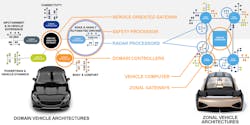What’s the Difference Between Domain and Zonal Automotive Architectures?
Many embedded solutions are designed around a domain-oriented approach—specific modules provide a function and controlled devices or sensors are wired to the module, often called electronic control units (ECUs). This works well in many applications, especially where the computation can be performed locally.
Such an approach can scale well if the devices and sensor placement remain close to the module, with additional modules being added to handle more devices and sensors. For example, a computer-controlled motor-control system that’s paired with the motor would scale nicely if an application needed a number of motors.
It becomes more challenging if sensors and devices are farther from the control module because of the additional wiring and interfacing that’s involved in the solution. Cabling becomes a major issue as more sensors and devices are added to the mix.
This is the case in many automotive applications. Thus, a networked-zone approach can provide better scalability as well as improved reliability and functionality. Typically, a central compute complex is linked to the sensors and devices through networked zonal gateways (see figure).
The network connections these days tend to be Ethernet. This includes various forms of automotive Ethernet. The zonal gateways aren’t just network switches, although the system-on-chip (SoC) solutions that are often used to implement a gateway will have an integrated network switch.
The zonal architecture scales better for numerous reasons, including providing a backbone for a software-driven framework. The approach simplifies cabling: Gateways are closer to sensors and devices they will be working with, and cabling between gateways and hosts is less complex.
Local processing at a gateway is possible. However, the flexibility is provided by the high-speed network links that can move data to and from the outer sensor and device environment to the heavy-duty compute servers located anywhere within the car.
This structural paradigm shift is in line with the movement to distributed software functionality and the ability to provide enhancements with new software.
About the Author
William G. Wong
Senior Content Director - Electronic Design and Microwaves & RF
I am Editor of Electronic Design focusing on embedded, software, and systems. As Senior Content Director, I also manage Microwaves & RF and I work with a great team of editors to provide engineers, programmers, developers and technical managers with interesting and useful articles and videos on a regular basis. Check out our free newsletters to see the latest content.
You can send press releases for new products for possible coverage on the website. I am also interested in receiving contributed articles for publishing on our website. Use our template and send to me along with a signed release form.
Check out my blog, AltEmbedded on Electronic Design, as well as his latest articles on this site that are listed below.
You can visit my social media via these links:
- AltEmbedded on Electronic Design
- Bill Wong on Facebook
- @AltEmbedded on Twitter
- Bill Wong on LinkedIn
I earned a Bachelor of Electrical Engineering at the Georgia Institute of Technology and a Masters in Computer Science from Rutgers University. I still do a bit of programming using everything from C and C++ to Rust and Ada/SPARK. I do a bit of PHP programming for Drupal websites. I have posted a few Drupal modules.
I still get a hand on software and electronic hardware. Some of this can be found on our Kit Close-Up video series. You can also see me on many of our TechXchange Talk videos. I am interested in a range of projects from robotics to artificial intelligence.


